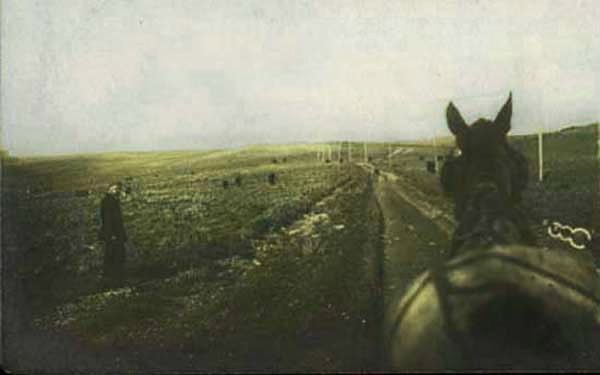
The Encampment Wagon Road, approx. 1907.
Prior to the arrival of the Saratoga and Encampment Railway in 1908, all people, merchandise, copper ore, smelted copper came
into or out of Encampment
by horse, mule, or ox on primitive wagon roads.
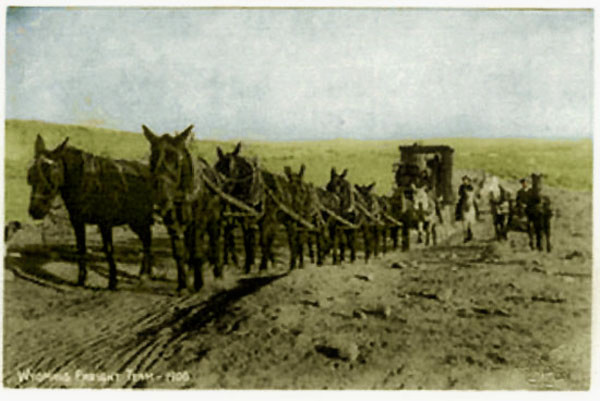
Traffic at a lay-by on the Encampment Wagon Road, approx. 1905.
Before construction of the
smelter, ore was shipped out in large ore wagons and even after construction of the smelter and before arrival of
the railroad, it was necessary to ship the refined copper out on the wagons. Indeed, the Grand Encampment
Herald, May 3, 1907, noted in a front page headline that 40,000 lbs. of blister copper left Encampment daily. Blister Copper
was an intermediate state of corrper refining, 98.5% to 99.5% pure. It was so called because of its blackened blistered
appearance. Penn-Wyoming,
the owner of the smelter at the time, owned its own
freight line. But carrying ore or even refined copper
in wagons just does not pay. The December 1, 1900, Industial Edition of the Laramie Republican noted of the Encampment Mining District,
"The one great need of the newly discovered country is better transportation facilities. At present only a few mines have ore rich enought to stand the
excessive wagon haul to the railroad and the shipment and treatment expense." Even after construction of the smelter and the
aerial tramway, ore from mines not convenient to the tramway had to haul the ore in wagons to the refinery.
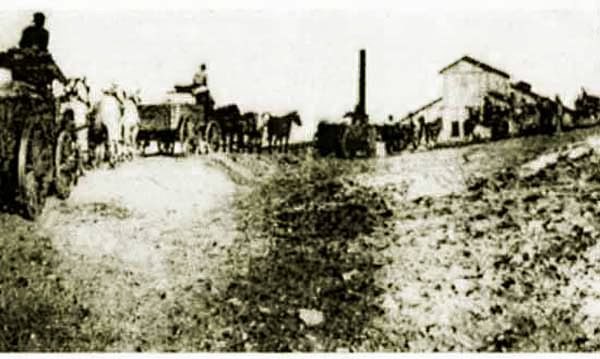
Wagons hauling ore, lined up before smelter.
Beginning about 1902, The Grand Encampment Herald endlessly repeated rumors of
various railroads coming to Encampment. First, it reported that surveying crews from the Union Pacific were in the area. Then it reported rumors that the
Laramie, Hahns Peak and Pacific was coming to Encampment, and then a wonderful rumor that Encampment would get two railroads,
the L.H.P. & P. and the Burlington. The rumor was that Burlington would extend its line from Thermopolis southward by way of
Encampment to Denver. Ultimately local investors constructed the Saratoga and Encampment arrivng in 1908. The fate of the Saatoga and
Encampment proved the wisdom of the other railroads in not constructing extensions into the town.

20-Horse freight train in front of Encampment Lumber and
Transportation Co., 1902,
Prior to 1903, the Encampment Lumber and Transportation Co. operated by Fred G. Grube, had a vertual monopoly on freighting in and out of
Encampment. In December 1897 most of the business men in Rawlins committed to making donations for the construction of a
wagon road to Encampment. Without a wagon road, the copper ore could not be brought out.
In 1899, Grube had proposed to connect Encampment to Rawlins
with a stage line with three twelve-passenger new Concord stages and three eighteen passenger coaches. It apparently was not to be. The necessary
bridges for a direct wagon road to Rawlins were not constructed until 1905. Grube's move to Encampment may have been prompted by bad luck in
Colorado. Grube was a partner with Charles A. Keith in the Keith & Grube Mining & Leasing Co. of Cripple Creek. Keith & Grube operated the Vindicator mine and ore transportation
services. On August 20, 1899, Keith was killed when he fell 150 feet down the shaft of the Orpha May mine. Subsequently a dynomite explosion
blew out the front of the company's building. Stage service by other providers was initially to Ft. Steele and later, after
a wagon road was constructed, to Walcott.
Prior to his involvement with
Encampment In June of 1902, Grube acquired the operations of
the Encampment Improvement and Transportation Company. By February 1903, Grube became "financially embarrassed" and his assets were
seized by a creditor. The Company filed for bankruptcy in Colorado. The assets were sold to the North American Mercantile Company
which had overlapping ownership with
Penn-Wyoming.The bankruptcy of Grube was not, however, as a result of operations in Encampment which were allegedly profitably.
North American had barns in Walcott as well as Encampment and the mercantile at Rudefeha. In addition to sale of building materials, hay, feed and
grain it maintained a blacksmith Department and freighting department with 115 head of horses.
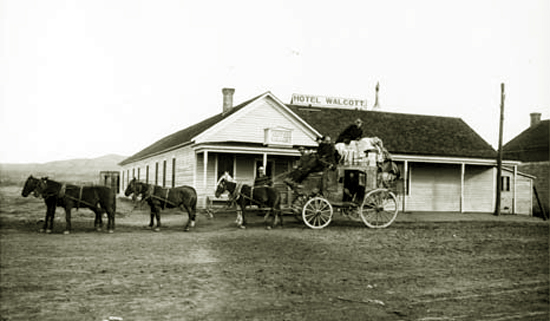
Walcott Hotel, approx. 1903
Walcott became the main jumping off point for those traveling to Saratoa or Encampment. There was a saloon, a feed stable, and the hotel with its roof sign.
Charles Winter described the building as having given "evidence of having been hastily erected. Behind each of them", he wrote,
the ground was littered with tin cans and bottles that flashed sharply in the unlight." winter continued: "
Not a house, not a tre, not a fence in sight! rocks, sand, lime, alkali; sun-baked, wind-swept, desolation-cursed! Undulating hills
of gray sagebrush as far as the eye could reach!. It seemed as though a patch of hell had been thrown up and dried there!"
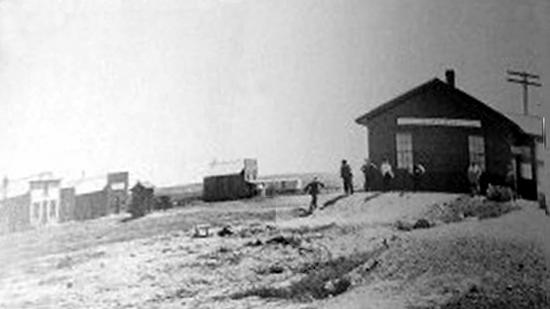
Walcott Railway Depot, 1901
About a block down the track were the platforms where the goods bound for Saratoga and Encampment were loaded on the triple wagons.
The platforms were loaded with boxes of canned goods, sacks of provisions, barrels, trunks and sections of mining equipment, to be hauled the fifty mile
trip to Encampment. For the "jerk-line" freighters it was a three day journey. For passengers on the six-horse Concord stages it was a day. Some of the
passengers rode "first-class" in the interior of the coaches. Others perched on the "hurricane deck" grasping the side rails.
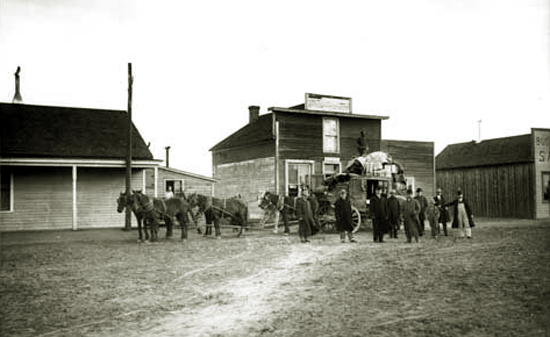
Walcott Post Office, approx. 1903
As observed in the next photo, not much from Charles Winter's description has changed.
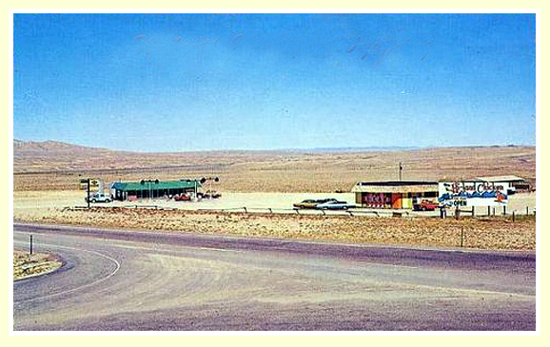
Walcott, approx. 1967.
|